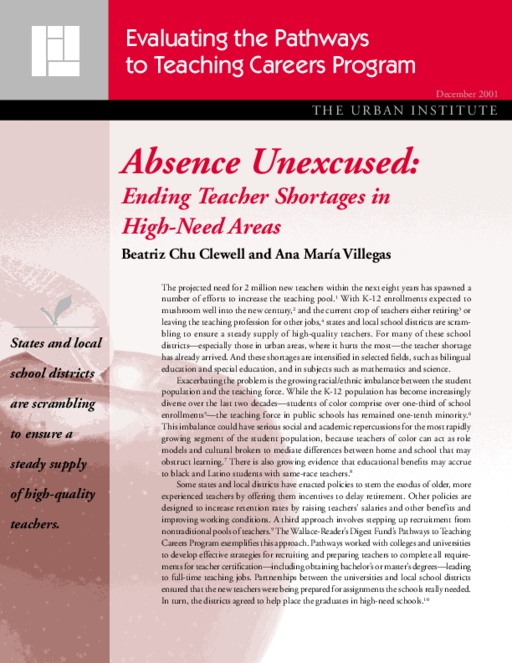Breadcrumb
- Wallace
- Reports
- Absence Unexcused Ending Teacher...
Absence Unexcused
Ending Teacher Shortages in High Need Areas

- Author(s)
- Beatriz Chu Clewell and Ana Maria Villegas
- Publisher(s)
- The Wallace Foundation
Summary
How we did this
The Pathways to Teaching Careers Program was evaluated using surveys and performance assessment data over the course of six and a half years, beginning in 1994.
The K-12 teacher shortage is an ongoing national challenge. In 1989, the Wallace Foundation launched a model that increased the number of effective teachers in hard-to-staff urban and rural schools. Teacher education programs and local school districts worked together to recruit non-traditional candidates. These included paraprofessionals and returning Peace Corps Volunteers.
This report by the Urban Institute summarizes program outcomes. It also draws conclusions aimed at policymakers that are still relevant today.
Evaluation Findings
The effort was called the Pathways to Teaching Careers Program. The Urban Institute found that:
- Pathways surpassed its recruitment goals. This shows that there is a substantial pool of qualified nontraditional teaching candidates ready to enter a demanding preparation program.
- The completion rate for Pathways participants was higher than the national rate for students in traditional teacher education programs.
- Pathways graduates teach in targeted school districts at very high rates.
- Pathways graduates are perceived as more effective as teachers than the typical beginning teacher. This is according to their supervisors, their principals, and a trained, independent assessor.
- Pathways graduates are more likely to remain in teaching for at least three years than the typical beginning teacher.
Policy Implications
The Urban Institute drew several policy implications from these findings:
- Recruiting new teachers from nontraditional pools is an effective way of increasing the national supply of teachers. Federal, state, and local policies should support programs that recruit from nontraditional pools.
- Paraprofessionals are a rich source of potential teachers. Carefully selected and supported paraprofessionals are as likely to become effective educators as those from traditional programs. They are also more likely to remain in high-needs districts. And they are more likely to reflect the race and ethnicity of the communities where they work.
- The Pathways model is an effective and affordable way to increase the teaching force’s size and diversity.
Key Takeaways
- The Pathways to Teaching Careers initiative successfully recruited and prepared non-traditional candidates for hard-to-staff urban and rural schools. These candidates included paraprofessionals and returning Peace Corps volunteers.
- The program’s success showed that a substantial pool of qualified nontraditional candidates exists and is ready to enter a demanding preparation program.
- The completion rate for Pathways participants was higher than the national rate for students in traditional teacher education programs.
- Pathways graduates are perceived as more effective as teachers than the typical beginning teacher. This is according to their supervisors, their principals, and a trained, independent assessor.
- Pathways graduates are more likely to remain in teaching for at least three years than the typical beginning teacher.


